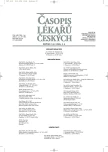Is Tamoxifene Porphyrinogenic?
Authors:
L. Malina; V. Mottl 1; H. Michalíková 2
Authors‘ workplace:
Katedra dermatovenerologie IPVZ, Praha
; Gynekologicko-porodnická klinika 3. LF UK a FNKV, Praha
1; Dermatovenerologická klinika 3. LF UK a FNKV, Praha
2
Published in:
Čas. Lék. čes. 2005; 144: 262-264
Category:
Original Article
Overview
Background.
As reported in previous studies, porphyria cutanea tarda (PCT) developed in several tamoxifene-treated patients with breast cancer. We studied the group of patients with cancer having only tamoxifene therapy after the initial surgery. We evaluated their clinical and laboratory results and compared them with the results of the group of patients suffering also from breast tumor, but treated after the surgery with other systemic therapies , mostly with chemotherapy.
Methods and Results.
20 patients were complexly studied, 10 of them with only tamoxifene therapy, and 10 without it. Diagnosis of the breast tumor was histologically confirmed in all of them. With the use of laboratory methods we examined their urinary excretion of diagnostically important porphyrins (uro - and coproporphyrin), then total blood count, liver function tests (ALT and AST), blood sugar, cholesterin, serum iron and ferritin, and performed also urinanalysis and detection of possible anti-HCV antibodies. The laboratory examination was repeated in the patient subgroup after three months, urinary uro - and coproporphyrin excretion also in the the control group, for to have an opportunity to follow the dynamics of laboratory changes. All the patients were examined during their regular laboratory controls performed so as not to be bothered with repeated additional phlebotomies. We did not confirm in our patients suffering from breast tumor the results of other autors, suggesting the connection between tamoxifene-therapy and development of porphyria cutanea tarda.
Conclusions.
Isolated cases of PCT can be induced through the effect of various hepatotoxic factors. However, the influence of common porphyrinogenically acting noxious substances (alcohol, HCV virus or iron overload as a result of the HFE gene mutations) were not found in our patients.
Key words:
tamoxifene, porphyria cutanea tarda, PCT, estrogenic hormons, cytostatic drugs, breast carcinoma.
Labels
Addictology Allergology and clinical immunology Angiology Audiology Clinical biochemistry Dermatology & STDs Paediatric gastroenterology Paediatric surgery Paediatric cardiology Paediatric neurology Paediatric ENT Paediatric psychiatry Paediatric rheumatology Diabetology Pharmacy Vascular surgery Pain management Dental HygienistArticle was published in
Journal of Czech Physicians

Most read in this issue
- Genomic Imprinting and Human Pathology
- Severe Lead Intoxication after Ingestion of Lead Shots
- Brugada Syndrome
- Is Tamoxifene Porphyrinogenic?
